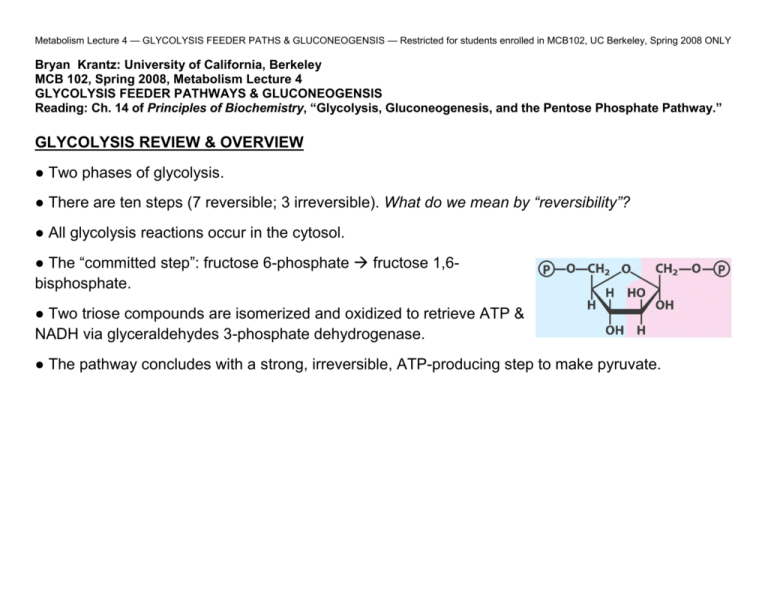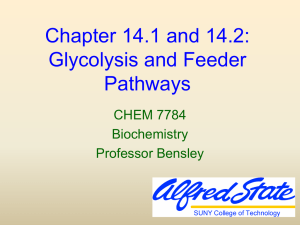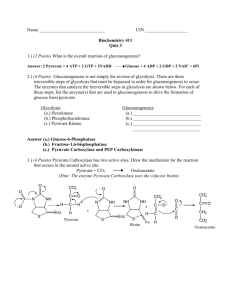Feeder Pathways & Gluconeogenesis
advertisement

Metabolism Lecture 4 — GLYCOLYSIS FEEDER PATHS & GLUCONEOGENSIS — Restricted for students enrolled in MCB102, UC Berkeley, Spring 2008 ONLY Bryan Krantz: University of California, Berkeley MCB 102, Spring 2008, Metabolism Lecture 4 GLYCOLYSIS FEEDER PATHWAYS & GLUCONEOGENSIS Reading: Ch. 14 of Principles of Biochemistry, “Glycolysis, Gluconeogenesis, and the Pentose Phosphate Pathway.” GLYCOLYSIS REVIEW & OVERVIEW ● Two phases of glycolysis. ● There are ten steps (7 reversible; 3 irreversible). What do we mean by “reversibility”? ● All glycolysis reactions occur in the cytosol. ● The “committed step”: fructose 6-phosphate fructose 1,6bisphosphate. ● Two triose compounds are isomerized and oxidized to retrieve ATP & NADH via glyceraldehydes 3-phosphate dehydrogenase. ● The pathway concludes with a strong, irreversible, ATP-producing step to make pyruvate. Metabolism Lecture 4 — GLYCOLYSIS FEEDER PATHS & GLUCONEOGENSIS — Restricted for students enrolled in MCB102, UC Berkeley, Spring 2008 ONLY PREPARATORY PHASE PAYOFF PHASE Metabolism Lecture 4 — GLYCOLYSIS FEEDER PATHS & GLUCONEOGENSIS — Restricted for students enrolled in MCB102, UC Berkeley, Spring 2008 ONLY GLUCONEOGENSIS Gluconeogenesis means new synthesis of glucose. It is the reverse of glycolysis. The body makes glucose in the liver (and also in the kidney). Why? ● Lactate accumulates in muscles (and red blood cells). ● Cells need a lot of glucose; our diet cannot provide all of it. ● Excess metabolites (e.g. after eating) may be conserved by converting to glucose and ultimately stored as glycogen, i.e., n Glucose Glycogen. ● Other required sugar and polysaccharides may use glucose precursors. ● Glucose is basically a universal fuel. Metabolism Lecture 4 — GLYCOLYSIS FEEDER PATHS & GLUCONEOGENSIS — Restricted for students enrolled in MCB102, UC Berkeley, Spring 2008 ONLY Overview: Gluconeogenesis is Anti-parallel to Glycolysis. Metabolism Lecture 4 — GLYCOLYSIS FEEDER PATHS & GLUCONEOGENSIS — Restricted for students enrolled in MCB102, UC Berkeley, Spring 2008 ONLY OVERVIEW: Precursor & Energy Requirement Summary for Gluconeogenesis. 2 Pyruvate + 4 ATP + 2 GTP, 2 NADH + 2 H+ + 4 H2O Glucose + 4 ADP + 2 GDP + 6 Pi + 2 NAD+ Why is this energy expensive synthesis even worth the trouble? Bypass Enzyme Reactions What are bypass reactions? Why are they needed for gluconeogenesis? There must be a way to bypass the irreversible steps in glycolysis to progress through gluconeogenesis. Generally, the bypass reactions are also irreversible. Why do irreversible steps exist in the first place? Regulating these points in the pathway can prevent “futile cycling”. Some enzymatic steps are difficult to catalyze reversibly, especially the ATP-driven ones. So bypass steps are required. Metabolism Lecture 4 — GLYCOLYSIS FEEDER PATHS & GLUCONEOGENSIS — Restricted for students enrolled in MCB102, UC Berkeley, Spring 2008 ONLY Pathways to Produce Phosphoenolpyruvate (PEP) Need PEP as a precursor to generate glucose. How do we obtain PEP? Pyruvate carboxylase. Bypass Step 1 of 2 in converting pyruvate to PEP. Pyruvate + HCO3- + ATP Oxaloacetate + ADP + Pi Mechanism. Enzyme uses biotin prosthetic group, which is an enzyme-linked co-factor that aids in catalysis. Role of the biotin is to activate bicarbonate via ATP hydrolysis. CO2 gas is then released, and the C-C double bond electrons of the enolate form of pyruvate attack CO2 to effectively carboxylate pyruvate. Energetics. The reaction requires one ATP. Regulation. As pyruvate carboxylase is the first enzyme catalyzed step in gluconeogeneis, it is a regulated step. A by-product of fatty acid catabolism is acetyl-CoA, which actually stimulates pyruvate carboxylase. Also the enzyme can provide oxaloacetate, which is an important metabolite in the TCA cycle (more on that in CH. 16.) Metabolism Lecture 4 — GLYCOLYSIS FEEDER PATHS & GLUCONEOGENSIS — Restricted for students enrolled in MCB102, UC Berkeley, Spring 2008 ONLY Malate dehydrogenase. Bypass Step 1 of 2 in converting pyruvate to PEP. This Step occurs in the mitochondrion, since [NADH] in the cytosol is low and NADH will be required ultimately to make glucose. Also there is no oxaloacetate transporter in mitochondria. Oxaloacetate + NADH + H+ Malate + NAD+ Malate is transported outside the cell, and there is a cytosolic malate dehydrogenase to remake oxaloacetate, by reversing the mitochondrial reaction: Malate + NAD+ Oxaloacetate + NADH + H+ Metabolism Lecture 4 — GLYCOLYSIS FEEDER PATHS & GLUCONEOGENSIS — Restricted for students enrolled in MCB102, UC Berkeley, Spring 2008 ONLY PEP carboxykinase. Oxaloacetate + GTP PEP + GDP + CO2 Mechanism. Oxaloacetate, in the presence of GTP, decarboxylates, and thus the γ phosphate of GTP is transferred to C2, yielding PEP. The carboxylation of the pyruvate was a means to activate the pyruvate for conversion to PEP, and thus the same CO2 that was added was subsequently stripped. Overall Energetics: The individual steps of the Pyruvate Carboxylase and PEP Carboxykinase catalyzed steps are highly exergonic (i.e. ΔG << 0). Though the overall energy change is slightly positive at std. conditions, Pyruvate + ATP + GTP + HCO3- PEP + ADP + GDP + 2 Pi (ΔGº’ = +0.9), the actual free energy under physiological conditions is -25 kJ/mol and very favorable, since the [PEP] is low as it is used up quickly in a variety of metabolic reactions. Metabolism Lecture 4 — GLYCOLYSIS FEEDER PATHS & GLUCONEOGENSIS — Restricted for students enrolled in MCB102, UC Berkeley, Spring 2008 ONLY Back through the reversible steps of Glycolysis using the same enzymes in reverse. Metabolism Lecture 4 — GLYCOLYSIS FEEDER PATHS & GLUCONEOGENSIS — Restricted for students enrolled in MCB102, UC Berkeley, Spring 2008 ONLY Another Bypass to PEP: When Lactate is Available Lactase dehydrogenase. Cytosolic enzyme interconverts lactate and pyruvate reversibly, using Redox chemistry and NAD+/NADH. Lactate + NAD+ pyruvate + NADH + H+ The pyruvate can then go through these other reactions to eventually get PEP. Basically, since there is little NADH in the cytosol (105 lower than in mitochondria), these alternate routes are required. If lactate is around then PEP is made inside the mitochondria by mitochondrial PEP carboxykinase. But if no lactate is around then Malate is produced inside the mitochondria so that a reducing equiv. may be effectively transferred to the cytosol. This is the pathway to recover lactate. The NADH will be required to make glucose, reversing STEP 6 of glycolysis, i.e., 1,3-Biphosphoglycerate Glyceraldehyde 3-phosphate Metabolism Lecture 4 — GLYCOLYSIS FEEDER PATHS & GLUCONEOGENSIS — Restricted for students enrolled in MCB102, UC Berkeley, Spring 2008 ONLY Phosphatases Catalyze Last Bypass Reactions & Complete Gluconeogenesis Fructose 1,6-bisphosphatase. Irreversible bypass step #2. This is a hydrolase, which means the Pi is removed and not captured by ADP to make ATP. Fructose 1,6-bisphosphate Fructose 6-phosphate + Pi Phosphoglucoisomerase. Reversible step using same enzyme from glycolysis. Fructose 6-phosphate Glucose 6-phosphate Glucose 6-phosphatase. Irreversible by pass step #3. Glucose 6-phosphate Glucose How is “Futile cycling” of ATP via these phosphatases and the kinases in glycolysis averted? Metabolism Lecture 4 — GLYCOLYSIS FEEDER PATHS & GLUCONEOGENSIS — Restricted for students enrolled in MCB102, UC Berkeley, Spring 2008 ONLY Where else do precursors for Gluconeogenesis come from? Mammals can use some amino acid carbon skeletons to make glucose. We call these amino acids glucogenic. They are metabolized and enter into the citric acid cycle (TCA cycle) to make oxaloacetic acid, leading to the production of PEP. But acetate (a break down product of fatty acid metabolism and greasy amino acids) cannot be used. These fatty amino acids are called ketogenic. Plants, yeast, and most bacteria can use acetate to make glucose, using acetyl-CoA and the glyoxylate cycle.








